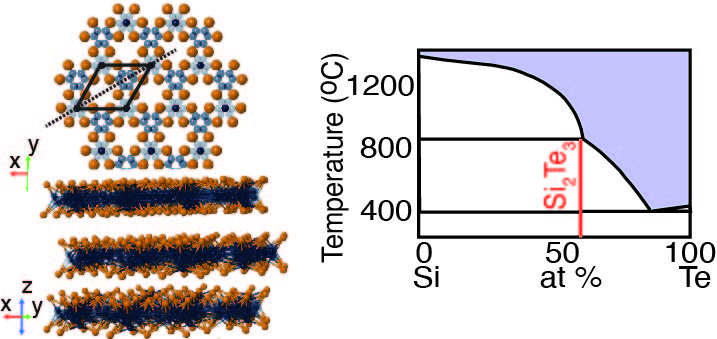Silicon Telluride (Si2Te3)
Silicon Tellluride:

Silicon Telluride has a trigonal crystal structure P-3 1 c with lattice constants a = 7.430 c = 13.482. Each layer consists of a row of close-packed Te atoms with Si dumbbells filling the interlayers in 2/3 of the octahedral sites and leaving about 1/3 of the octahedral sites vacant. The temperature - composition phase diagram has only one composition (Si2Te3) with both a high temperature and low temperature phase. The high temperature phase is black-grey and low temperature phase is transparent red. Si2Te3 is a p-type semiconductor with a direct bandgap at around 2.0 eV and an indirect gap at around 1 eV.
Chemicals:
Silicon, tellurium, quartz or sapphire substrates
Synthesis Setup:

Large-Area Vapor-Liquid-Solid Growth Procedure:
Silicon telluride grows via a large-area VLS (vapor-liquid-solid) route or just simply V-S (vapor-solid). VLS grows hexagonal plates lying flat on a surface from a pool of tellurium. VS growth yields half hexagons standing on a substrate like a graveyard.
We use Lindberg Blue tube furnaces for growth. A 12 in. tube furnace with a 1 in. diameter quartz tube is used for growth. Tellurium and silicon powders are ground together in a marble crucible and placed in a ceramic coors boat in the center of the tube and furnace. Downstream, we place a substrate of fused quartz, or sapphire (aluminum dopes Si2Te3). The position is chosen to reach about 400-680°C for growth. The tube is evacuated using the amazing Varian DS302 dual vane rotary pump to about 0.1 Torr or less. The tube is flushed several times with Argon gas. The gas flow is kept at 15 sccm. The furnace is heated to 800°C with a ramp rate of 60°C per min. As soon as the furnace temperature reaches 800°C, heating is stopped and the substrates are allowed to cool naturally to room temperature. Growth is fast! Typically on the order of 30 minutes to an hour. Silicon telluride hydrolyzes very quickly so it is important to transfer them to vacuum or an air-free glovebox.
It is also possible to grow morphologies of nanoribbons. See the references below for details!
Example Crystals

Relevant Publications:
S. Keuleyan, M. Wang, F.R. Chung, J. Commons, K.J. Koski, A Silicon-Based Two-Dimensional Chalcogenide: Growth of Si2Te3 Nanoribbons and Nanoplates. Nano Lett. 15, 2285-2290 (2015).
M. Wang, G. Lahti, D. Williams, K.J. Koski, Chemically tunable full spectrum optical properties of 2D silicon telluride nanoplates. ACS Nano, 12 6163-6169 (2018)



